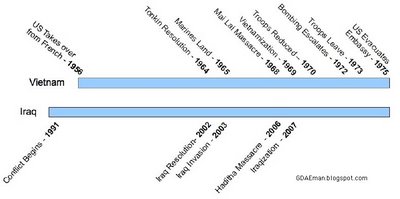 Conventional wisdom is that the Iraq war is evolving more rapidly than the Vietnam war. This might be based on a perception of more rapid growth in public opposition to the Iraq war. However, the US has been at war with Iraq since about 1990, with military actions occurring before the October 2002 Joint Iraq Resolution. (See References to Iraq No Fly Zone). The Vietnam conflict involved a similar period of covert US intervention prior to formal escalation.
Conventional wisdom is that the Iraq war is evolving more rapidly than the Vietnam war. This might be based on a perception of more rapid growth in public opposition to the Iraq war. However, the US has been at war with Iraq since about 1990, with military actions occurring before the October 2002 Joint Iraq Resolution. (See References to Iraq No Fly Zone). The Vietnam conflict involved a similar period of covert US intervention prior to formal escalation.For purposes of comparing time lines, the October 2002 Joint Iraq Resolution is analogous to the 1964 Tonkin Gulf Resolution of the Vietnam War. Significant numbers of US troops entered Iraq in March 2003, Marines entered Vietnam in 1965; the time lines match.
In 1966, veterans of past wars were staging protests in New York City and burning their discharge papers. The Congress of Racial Equality (CORE) issues a report claiming that the US military draft places "a heavy discriminatory burden on minority groups and the poor." The group also calls for a withdrawal of all US troops from Vietnam. Just a year into the escalated war.
In 1968 the Americans become aware of the Mai Lai Massacre. The timing is similar to Americans becoming aware of the massacre in Haditha, and other atrocities, in 2006.
It was about four years after the Tonkin Gulf Resolution that the 1969 Policy of "Vietnamization" was announced. Secretary of Defense Melvin Laird described a policy of shifting the military burden onto the South Vietnamese Army and away from the United States. It will have been about four years to reach a similar milestone of Iraqization of the war (Oct. 2002 to Jan. 2007*).
The time lines are actually quite similar. The number of casualties is not. In Vietnam, by 1969 about 47,000 US lives were lost. In Iraq, the number will be about 3,000.
Now what happens? Analogous Iraq dates are in parentheses. In 1969 (2007), concurrent with the "Vietnamization Policy," massive demonstrations occurred in Washington, DC. Secret bombing of Cambodia initiated by Nixon.
In 1970 (2008), troop levels were significantly reduced.
In 1972 (2010), Nixon cut troop levels in Vietnam and escalated bombing. Kissinger says "peace is at hand."
In 1973 (2011), cease-fire is signed in Paris. Last troops supposedly leave Vietnam.
In 1975 (2013), Americans evacuate the US Embassy.
One year after announcing the Vietnamization Policy US troops were reduced. It took three years from that point to reach a cease-fire. Two more years and the US was out of Vietnam. That translates to six-years from the January 2007 announcement of the Iraqization Policy to come.
Noam Chomsky says the Iraq war is NOT like the Vietnam war in significant ways. US plutocratic objectives could achieved by crushing Vietnam and leaving it a wreck. Wrecking Iraq won't achieve US plutocratic goals in Iraq. If he's right, the US will NOT be out of Iraq in six years.
Notes and Sources:
* Military commanders who met on December 12 2006 with Bush sought more advisers to train the Iraqis, not more U.S. combat troops in Iraq. They also urged the administration to pour significantly more funding into equipment for Iraqi security forces, according to a defense specialist familiar with the meetings. (Iraqization policy to be formally announced in January, 2007). Web LINK
Al-Maleki Take Note:
1963, Diem Overthrown, Murdered. It doesn't fit with the parallel time line laid out above, but...... With tacit approval of the United States, operatives within the South Vietnamese military overthrow Diem. He and his brother Nhu are shot and killed in the aftermath. About a year before, Johnson had visited Diem, assuring him that he was crucial to US objectives in Vietnam, calling him "the Churchill of Asia."
Text from the Vietnam Time line used liberally above.
~



1 comment:
Interesting comparison. I have to wonder though about the permanent bases.
Post a Comment